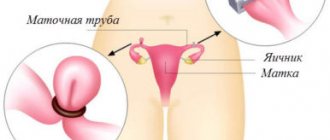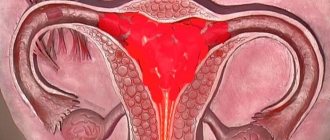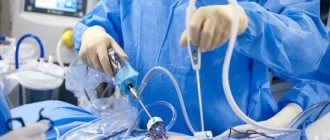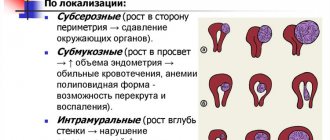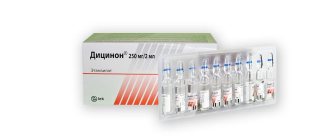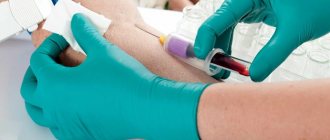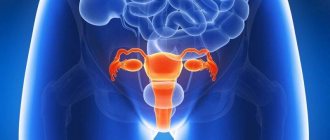The essence of uterine artery embolization in the treatment of uterine fibroids - why is the operation performed?
The manipulation in question in some medical sources is also called embolization of uterine fibroids.
The purpose of the procedure is to block the flow of blood to the fibroid , which favors its reduction. To do this, a microscopic particle is introduced into the uterine artery - an embolus . Often preference is given to emboli that are made of medical plastic. Although in practice, particles from other hypoallergenic and body-safe materials can be used.
After entering a blood vessel, this particle clogs its lumen, cutting off the flow of blood to the fibroid. At the same time, the uterus retains its viability: it is supplied by the ovarian arteries, and the muscle components of the fibroids, after a certain period of time, are replaced by connective tissue. Fibrous formations self-destruct over time.
Video: Uterine artery embolization (UAE) for uterine fibroids
UAE is used regardless of the number of pathological nodes and their parameters. Through this manipulation, you can significantly reduce the size of myomatous nodes, and in some cases, get rid of them altogether.
In extremely rare cases, additional therapeutic measures may be used.
Intervention in the patient’s reproductive system during this procedure is minimal.
In addition, if there were difficulties with conception due to fibroids, after embolization of the uterine arteries the woman has every chance of becoming pregnant.
Blood supply to the pelvic organs
Anything incomprehensible first of all causes fear and apprehension. Unlike surgery, where everything is more or less clear and familiar - anesthesia, incision, removal, suturing - the embolization process is difficult to understand not only for patients, but also for some gynecologists.
For many, there is an equal sign between the process of stopping the blood supply to an organ and the necrosis of this organ. Indeed, if you tie your hand with a tourniquet, then within a few hours the hand will become dead. But the arm does not have additional arteries that could supply it with blood, bypassing the one that was pinched with a tourniquet.
There are organs in the body that have no additional blood supply other than the main artery of that organ, and blockage of this single artery will always lead to necrosis. At the same time, there are organs whose blood supply is quite complex and is not limited only to the main trunks. Most organs located in the pelvis have several sources of blood supply, and cessation of blood flow through one of the arteries does not in any way affect the condition of the organ as a whole and its functioning.
The uterus is just such an organ. In addition to the uterine arteries, the uterus is also supplied with blood by the ovarian arteries and arteries from the broad ligament of the uterus. Ligation of both uterine arteries has never led to uterine necrosis. This method has been used for many decades in case of heavy uterine bleeding.
Since the beginning of the twentieth century, the technique of ligating larger pelvic arteries has been used for bleeding from which several large arteries originate, including the uterine one, and this does not lead to organ necrosis. In other words, for more than a hundred years in medicine, ligation of large arteries in the small pelvis has been widely used without any consequences, while embolization of an organ is a selective procedure that does not involve a complete 100% cessation of blood supply, but the closure of a predominantly pathological vascular network that appeared in as a result of the appearance of nodes - uterine fibroids.
Indications and contraindications for UAE
This procedure may be prescribed for the following conditions:
- Large parameters of the uterus: as in women in the 9th or more weeks of pregnancy.
- Heavy periods.
- The patient's desire to maintain the viability of the uterus.
- The presence of contraindications to surgical intervention, as well as to hormonal therapy.
- Regular pain.
- Malfunctions of the pelvic organs and/or their compression.
- Diagnosis of multiple/single myomatous nodes, the diameter of which is no more than 8 cm. If the size of the pathological nodes is larger, the doctor may decide to perform UAE as a preparatory procedure before removing the fibroids using an invasive method.
- Infertility caused by uterine fibroids.
This type of treatment cannot be prescribed for the following pathologies:
- The period of bearing a child.
- Infection of the body.
- Serious problems with the liver and/or kidneys.
- Allergic reactions to iodine-containing, radiopaque substances.
- Inflammatory phenomena in the genital area.
- Disorders associated with blood clotting.
- A significant increase in the volume of the uterus (as in women at 20 weeks of pregnancy), associated with the gigantic diameter of the myomatous nodes.
- Cancer of the uterus or a precancerous condition.
- In addition, in the case of UAE in the presence of subserous nodes on a thin stalk, there is a risk of developing peritonitis in the future. Therefore, to treat such tumors, the doctor opts for other methods.
How uterine embolization is performed - video and stages of UAE surgery
Before the manipulation in question, the patient must undergo a full examination, which includes:
- Blood testing for certain sexually transmitted diseases.
- General analysis of blood, urine, and stool.
- Checking blood type and Rh factor.
- Fluorography.
- Electrocardiogram.
- Detailed blood test.
- Bacteriological, cytological examination of smears.
- Colposcopy.
- Endometrial scraping.
- Angiography of the vascular network that nourishes the uterus.
- MRI. If you suspect the presence of a malignant neoplasm in the body or cervix.
Preparation for surgery:
- 5 days before the procedure, the patient should take antibacterial agents.
- Women with a low pain threshold are prescribed sedatives, and on the day of UAE they are given an additional dose of painkillers.
- On the day of surgery, you are prohibited from consuming any food or liquid.
- You should also shave your groin area and bring elastic bandages or compression stockings.
- At least two hours before surgery, the patient is given an intravenous infusion of an antibiotic to prevent infection of the body. Ceftriaxone is often used.
Video: Uterine artery embolization
Algorithm for uterine artery embolization:
- Local anesthesia.
- Piercing the right common femoral artery. The operator determines its location by palpation of the groin area. The operating area is treated with a disinfecting solution, and a medical needle is inserted into the lumen of the artery at a certain angle.
- Arterial catheterization. A radiopaque catheter with a soft tip is introduced using an introducer.
- Introducing a contrast agent and performing angiographies to assess the quality of the blood supply to the uterus, as well as to obtain an image of the entire network of blood vessels that envelop the fibroid. At this time, the patient may feel discomfort (tingling, warmth) in the uterine area. The reason for this is a coloring substance that moves through the arteries.
- Direct embolization. For such purposes, a syringe with embolic particles is connected to a catheter, which ensures that the microspheres enter the bloodstream. Over time, the lumen of the necessary blood vessels becomes blocked.
- Carrying out a control angiogram and ultrasound examination. If there is no blood flow in the area of the fibroids, the doctor removes the catheter.
Angiograms before and after uterine artery embolization
- Press the puncture site with your finger until the bleeding stops completely, treat the surgical site with antiseptics, and apply a bandage for 12 hours.
- In the absence of any errors in the structure of the circulatory network, the operation lasts, on average, 30 minutes .
Infection and peritonitis
Infectious complications, including peritonitis, are also impossible if the rules of patient preparation are followed. Obviously, if the patient has an inflammatory process, she will not undergo embolization of uterine fibroids until the inflammation is eliminated. In addition, the preparation program for the procedure includes prophylactic antibiotics. Antibiotics are administered immediately before the procedure and after, for 5 days. That is, the possibility of developing the inflammatory process is blocked many times over. Violations and deviations from the standard of care for patients with UAE can indeed lead to the development of infectious complications.
The result of uterine embolization - what happens to the fibroids?
- In the first few hours after surgery, the muscle cells of the fibroid die off, which is accompanied by pain.
- The most active reduction of pathological nodes is observed in the first six months after the manipulation in question.
- Often, after a year, the uterus acquires normal parameters, and myomatous nodes are reduced by 4 times.
The speed and nature of regressive phenomena will be determined by the parameters and location of the nodes. If these nodes are located in the area of the posterior wall of the uterus, their size will decrease slowly. When localized close to the uterine cavity, pedunculated nodes can break off and migrate outward.
To monitor the process of fibroid transformation, an ultrasound examination of the pelvic organs should be performed 3 months, six months and a year after embolization.
In the future, it is necessary to be examined by a gynecologist every 6 months in order to exclude relapse.
Video: Embolization of arteries of uterine fibroids
Post-embolization period
There is no pain during the procedure, but may appear after it. Severe nagging pain in the lower abdomen is associated with ischemia of fibroid cells. Unpleasant sensations arise due to medical intervention. The patient goes through this stage quickly. To reduce pain, you must take painkillers prescribed by your doctor.
At first, you may experience fever, weakness and general malaise. Symptoms pass quickly and without health consequences.
Recovery after UAE surgery and recommendations for patients – can there be complications?
The patient needs rest for the first 8 hours after the procedure. The bandaged leg must be kept in a horizontal position, and an ice pack is applied to the site of manipulation for the first couple of hours. This helps reduce swelling and relieve pain.
The patient should wear compression garments on her legs for the first few days.
If there are no exacerbations, you are allowed to go home after 1-3 days. Before leaving the hospital, the doctor performs an ultrasound examination.
After embolization of the uterine arteries, the following phenomena may be of concern:
- Slight increase in body temperature.
- Prostration.
- Pain in the lower abdomen. To eliminate them, painkillers are prescribed.
- Nausea.
- Vomit. This post-embolization syndrome is relieved with antiemetic therapy.
- Bloody vaginal discharge. The menstrual cycle is completely normalized within 3 months after UAE.
Such phenomena can occur from several days to several weeks.
Within a month after this procedure, patients are prohibited from:
- Visit saunas, as well as stay in direct sunlight for a long time.
- Undergo any physical procedures in the uterine area.
- Engage in active sports.
- Take baths.
- Have vaginal sex.
Side effects with this procedure are extremely rare, but they do occur.
These include:
- The appearance of a hematoma in the area of the artery puncture. No therapeutic measures are required to eliminate it - it resolves on its own.
- Migration of the node into the peritoneum or uterus.
- Embolization of nearby organs as a result of emboli entering the blood vessels that supply them. A similar condition can develop against the background of individual anatomical features.
- Inflammatory processes in the uterus, accumulation of purulent masses in its cavity. These negative conditions can occur with extensive death of myometrial cells. In this case, the uterus is removed urgently.
- Vaginal dryness, lack of sexual desire. Occurs when the cervicovaginal vessels are blocked.
Price of uterine embolization in Russian clinics
The cost of the manipulation in question will be determined by several factors:
- The status of the medical institution. The amount for such an operation in public clinics is often lower than in private ones.
- Experience and authority of the surgeon.
- The number of tests that the patient needs to undergo. If there are concomitant diseases, the examination will be more extensive, which means more financial resources will be spent.
- A variety of medications that must be taken or punctured before embolization of the uterine artery.
- The volume of dye for angiography.
- Postoperative measures. This includes the number of days spent in hospital; list of instrumental and laboratory examinations; number of consultations with the doctor.
On average, the price for uterine artery embolization in Moscow clinics will be 110,000 rubles.
Rate
—

